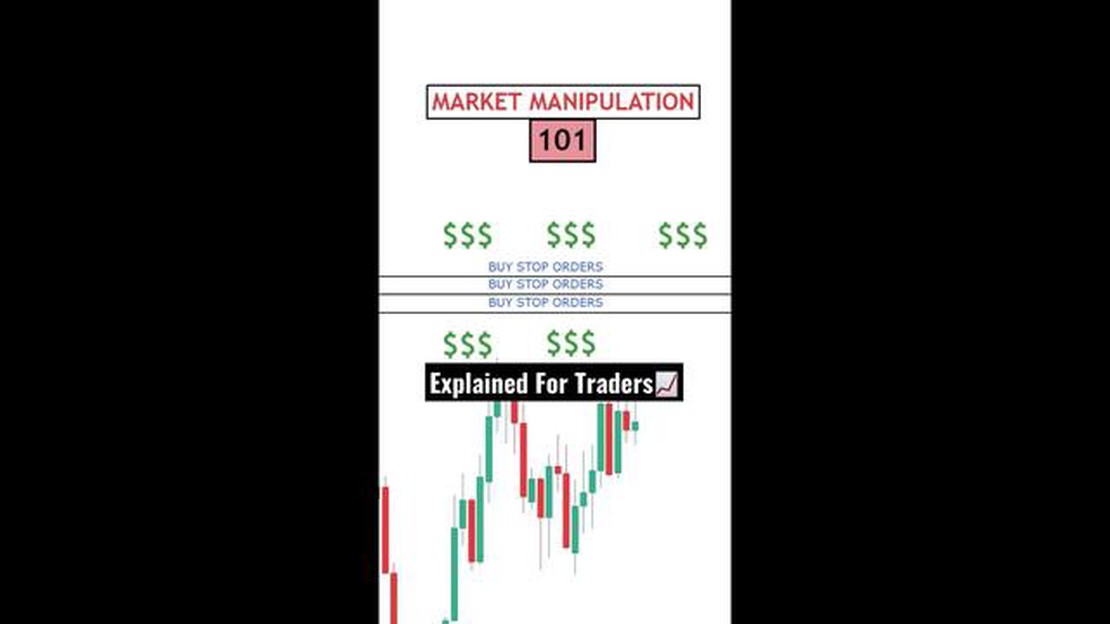Is Auto Trading Legit? The Truth Revealed
Is Auto Trading Legit? Auto trading, also known as algorithmic trading or robotic trading, has gained a lot of attention in recent years. The idea of …
Read Article
Stock manipulation is a deceptive practice that involves artificially influencing the price of a security for personal gain. It is a complex and controversial issue that has significant consequences for investors, markets, and the overall stability of the financial system. Understanding the techniques used in stock manipulation, its consequences, and the measures taken to prevent it is crucial for both individual investors and regulatory bodies.
One of the most common techniques used in stock manipulation is known as “pump and dump.” In this scheme, manipulators artificially inflate the price of a stock by spreading false information or through aggressive buying. Once the price has risen to a desired level, they sell their shares, causing the price to plummet and leaving unsuspecting investors with significant losses.
The consequences of stock manipulation can be devastating. Not only do individual investors suffer financial losses, but the manipulation can also erode trust in the integrity of the financial markets. Market participants may become hesitant to invest, and the overall stability of the economy can be put at risk. Furthermore, stock manipulation can distort market signals, leading to inefficient resource allocation and hindering economic growth.
To combat stock manipulation, regulatory bodies have implemented various measures. One approach is to increase transparency and disclosure requirements, making it more difficult for manipulators to spread false information. Additionally, regulators have enhanced surveillance and enforcement efforts to detect and punish those engaged in manipulation. The cooperation between regulatory agencies and exchanges has also played a crucial role in preventing stock manipulation.
In conclusion, stock manipulation is a deceptive practice that has serious consequences for investors and the financial system as a whole. Understanding the techniques used, its consequences, and the measures taken to prevent it is vital for individuals and regulatory bodies alike. By staying informed and vigilant, we can work towards creating a fair and transparent financial market that benefits everyone involved.
Stock manipulation refers to the illegal activities and practices intended to inflate or deflate the value of a stock for personal gain. These manipulative techniques have the potential to disrupt the integrity of financial markets and harm unsuspecting investors. Understanding the different techniques used can help investors recognize and protect themselves from stock manipulation.
 2. Pump and dump: This technique involves artificially inflating the price of a stock through spreading false or misleading information. Once the stock price rises, the manipulator sells their shares at a profit, leaving other investors with overpriced stocks that eventually fall in value.
3. Insider trading: Insider trading involves the buying or selling of a stock based on non-public, material information about the company. This unfair advantage allows insiders to profit from the knowledge that has not been disclosed to the general public.
2. Pump and dump: This technique involves artificially inflating the price of a stock through spreading false or misleading information. Once the stock price rises, the manipulator sells their shares at a profit, leaving other investors with overpriced stocks that eventually fall in value.
3. Insider trading: Insider trading involves the buying or selling of a stock based on non-public, material information about the company. This unfair advantage allows insiders to profit from the knowledge that has not been disclosed to the general public.
Read Also: Understanding the Terminology in Options Trading: A Guide for Beginners4. Front running: Front running occurs when a trader or broker executes orders on a security for their own account while having advance knowledge of pending orders from clients. This unethical practice allows the manipulator to take advantage of the price movements that result from the client’s orders. 5. Corners: Corners involve manipulating the supply of a particular stock by accumulating a significant number of shares in order to control its price and demand. This enables the manipulator to dictate the market and potentially force other investors to buy shares at inflated prices. 6. Spread manipulation: Spread manipulation occurs when a manipulator artificially increases the spread between the bid and ask prices of a stock. This can create a false impression of market conditions and lead to unsuspecting investors unknowingly paying higher prices for the stock. 7. False rumors: Spreading false rumors or misleading information about a company can significantly impact its stock price. Manipulators use this technique to create a panic or hype, which can lead to increased trading activities and price volatility.
It is important for investors to be aware of these stock manipulation techniques and exercise caution in their investment decisions. Regulatory authorities play a crucial role in monitoring and preventing such manipulative practices to ensure fair and transparent markets.
The pump and dump scheme is an unscrupulous and illegal technique used to manipulate the price of stocks. It involves artificially inflating the price of a stock through false or misleading statements, in order to attract unsuspecting investors, only to sell off the overvalued shares at a profit, causing the price to collapse.
In a pump and dump scheme, the manipulators typically target low-priced stocks or penny stocks that have a small market capitalization. They take advantage of the limited liquidity and lack of information about these stocks to exploit inexperienced investors. The manipulators may use various tactics to create a sense of excitement or urgency around the stock, such as spreading false rumors, engaging in aggressive promotional campaigns, or creating fake social media profiles to endorse the stock.
Once the price of the stock has been artificially pumped up, the manipulators sell off their shares at the inflated price, realizing substantial profits. This mass selling triggers a rapid decline in the stock price, leaving unsuspecting investors with significant losses. The manipulators, having already exited their positions, often move on to their next target, leaving behind a trail of victims.
Read Also: How to Trade Forex on Linux: A Complete Guide
The consequences of falling victim to a pump and dump scheme can be devastating for investors. Not only do they suffer financial losses, but their confidence in the stock market may be severely eroded. Additionally, these schemes can undermine market integrity and erode trust in the fairness and transparency of the financial markets.
Preventing pump and dump schemes requires a combination of education, regulation, and enforcement. Investors should be wary of unsolicited investment advice, do thorough research before making investment decisions, and consult with licensed financial professionals. Regulators and law enforcement agencies need to actively investigate and prosecute individuals and groups involved in pump and dump schemes, sending a strong message that such behavior will not be tolerated.
In conclusion, pump and dump schemes are a deceitful and unethical practice that can have serious consequences for investors and the overall integrity of the stock market. Awareness and vigilance are crucial in safeguarding against such manipulative schemes, and regulators must remain vigilant in their efforts to detect and punish those responsible.
Stock manipulation refers to the illegal practice of artificially inflating or deflating the price of a stock for personal gain. It involves techniques such as spreading false information, manipulating trading volumes, or engaging in fraudulent trading activities.
Stock manipulation can have significant consequences for the stock market. It can distort the true value of stocks, create an unfair trading environment, and undermine investor confidence. It may also lead to market volatility, as manipulated prices can often result in sudden and unpredictable price movements.
There are several common techniques used in stock manipulation. These include pump and dump schemes, where fraudsters artificially inflate the price of a stock and then sell their shares at a profit, and bear raids, where traders collude to drive down the price of a stock by aggressively selling short. Other techniques include spreading false rumors, painting the tape, and front-running.
The consequences of stock manipulation can be severe. For individual investors, it can result in financial losses if they buy or sell stocks based on manipulated prices. It can also damage the overall reputation of the stock market, leading to a loss of trust and decreased participation from investors. In extreme cases, stock manipulation can be prosecuted as a crime and perpetrators may face heavy fines and even imprisonment.
Preventing stock manipulation requires a combination of regulatory measures and investor vigilance. Regulators can implement stricter enforcement of securities laws and increase surveillance of trading activities. Investors, on the other hand, should conduct thorough research before making investment decisions, be cautious of suspicious rumors or sudden price movements, and report any suspected cases of manipulation to the appropriate authorities.
Is Auto Trading Legit? Auto trading, also known as algorithmic trading or robotic trading, has gained a lot of attention in recent years. The idea of …
Read ArticleHow do CLOs make money? Collateralized Loan Obligations (CLOs) are complex financial instruments that generate revenue through a unique profit …
Read ArticleStep-by-Step Guide: Installing Drivers on Windows Installing drivers on Windows is an essential task to ensure optimal performance of your hardware …
Read ArticleDoes BPI sell foreign currency? BPI, also known as Bank of the Philippine Islands, is one of the largest banks in the Philippines with a wide range of …
Read ArticleWhat does FX mean in finance? FX, in the world of finance, refers to foreign exchange. The term represents the process of converting one currency into …
Read ArticleUnderstanding FX Options Trading: Everything You Need to Know FX options trading is a complex and exciting way to participate in the global foreign …
Read Article